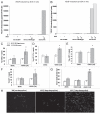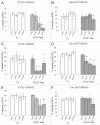Effect of VEGF and VEGF Trap on vascular endothelial cell signaling in tumors
- PMID: 21079419
- PMCID: PMC3047090
- DOI: 10.4161/cbt.10.12.14009
Effect of VEGF and VEGF Trap on vascular endothelial cell signaling in tumors
Abstract
Vascular endothelial growth factor (VEGF) A is a major promoter of tumor angiogenesis and a prime target of antiangiogenic cancer therapy. To examine whether endothelial cell signaling might provide histological biomarkers of angiogenesis and VEGF activity in vivo, normal mouse organs and multiple tumor models were studied immunohistochemically for endothelial expression of activated ERK, STAT3, and AKT. Phospho(p)-ERK and p-STAT3 expression was negligible in the endothelia of normal organs but was significantly elevated in tumor endothelium. p-AKT was present at significant and comparable levels in both tumor and normal endothelia. In K1735 tumors induced to express more VEGF, endothelial p-ERK, p-STAT3 and p-AKT increased accompanied by signs of accelerated angiogenesis. Treatment of K1735 and Colo-205 tumors with the VEGF inhibitor, VEGF Trap (aflibercept), decreased tumor endothelial p-ERK, p-STAT3 and p-AKT expression accompanied by signs of antiangiogenic effect. These results show that endothelial p-ERK and p-STAT3 (but not p-AKT) distinguish tumor from normal vessels and that the presence of these two signaling intermediates may be useful indicators of tumor angiogenic activity and angiogenesis inhibition by VEGF antagonist.
Figures





Similar articles
-
Ellagic acid inhibits VEGF/VEGFR2, PI3K/Akt and MAPK signaling cascades in the hamster cheek pouch carcinogenesis model.Anticancer Agents Med Chem. 2014;14(9):1249-60. doi: 10.2174/1871520614666140723114217. Anticancer Agents Med Chem. 2014. PMID: 25060902
-
Dual blockade of vascular endothelial growth factor (VEGF) and basic fibroblast growth factor (FGF-2) exhibits potent anti-angiogenic effects.Cancer Lett. 2016 Jul 28;377(2):164-73. doi: 10.1016/j.canlet.2016.04.036. Epub 2016 Apr 26. Cancer Lett. 2016. PMID: 27130666
-
Luteolin inhibits vascular endothelial growth factor-induced angiogenesis; inhibition of endothelial cell survival and proliferation by targeting phosphatidylinositol 3'-kinase activity.Cancer Res. 2004 Nov 1;64(21):7936-46. doi: 10.1158/0008-5472.CAN-03-3104. Cancer Res. 2004. PMID: 15520200
-
Vascular endothelial cell growth factor (VEGF), an emerging target for cancer chemotherapy.Curr Med Chem Anticancer Agents. 2003 Mar;3(2):95-117. doi: 10.2174/1568011033353452. Curr Med Chem Anticancer Agents. 2003. PMID: 12678905 Review.
-
Targeting Angiogenesis in Cancer Therapy: Moving Beyond Vascular Endothelial Growth Factor.Oncologist. 2015 Jun;20(6):660-73. doi: 10.1634/theoncologist.2014-0465. Epub 2015 May 22. Oncologist. 2015. PMID: 26001391 Free PMC article. Review.
Cited by
-
Newcastle disease virus expressing an angiogenic inhibitor exerts an enhanced therapeutic efficacy in colon cancer model.PLoS One. 2022 Apr 5;17(4):e0264896. doi: 10.1371/journal.pone.0264896. eCollection 2022. PLoS One. 2022. PMID: 35381011 Free PMC article.
-
Antiangiogenic therapies in non-small-cell lung cancer.Curr Oncol. 2018 Jun;25(Suppl 1):S45-S58. doi: 10.3747/co.25.3747. Epub 2018 Jun 13. Curr Oncol. 2018. PMID: 29910647 Free PMC article. Review.
-
Efficacy and safety of aflibercept in in vitro and in vivo models of retinoblastoma.J Exp Clin Cancer Res. 2016 Nov 4;35(1):171. doi: 10.1186/s13046-016-0451-7. J Exp Clin Cancer Res. 2016. PMID: 27814771 Free PMC article.
-
The progress of targeted therapy in advanced gastric cancer.Biomark Res. 2013 Dec 11;1(1):32. doi: 10.1186/2050-7771-1-32. Biomark Res. 2013. PMID: 24330856 Free PMC article.
-
Increased HCMV seroprevalence in patients with hepatocellular carcinoma.Virol J. 2011 Oct 27;8:485. doi: 10.1186/1743-422X-8-485. Virol J. 2011. PMID: 22032643 Free PMC article.
References
-
- Ellis LM, Hicklin DJ. VEGF-targeted therapy: mechanisms of anti-tumour activity. Nat Rev Cancer. 2008;8:579–591. - PubMed
-
- Hicklin DJ, Ellis LM. Role of the vascular endothelial growth factor pathway in tumor growth and angiogenesis. J Clin Oncol. 2005;23:1011–1027. - PubMed
-
- Ferrara N. Vascular endothelial growth factor: basic science and clinical progress. Endocr Rev. 2004;25:581–611. - PubMed
-
- Olsson AK, Dimberg A, Kreuger J, Claesson-Welsh L. VEGF receptor signaling—in control of vascular function. Nat Rev Mol Cell Biol. 2006;7:359–371. - PubMed
-
- Takahashi H, Shibuya M. The vascular endothelial growth factor (VEGF)/VEGF receptor system and its role under physiological and pathological conditions. Clin Sci (Lond) 2005;109:227–241. - PubMed
Publication types
MeSH terms
Substances
Grants and funding
LinkOut - more resources
Full Text Sources
Miscellaneous
